Class Warfare Evolved: How Item Unlocks Redefined Team Fortress 2 Team Fortress 2.
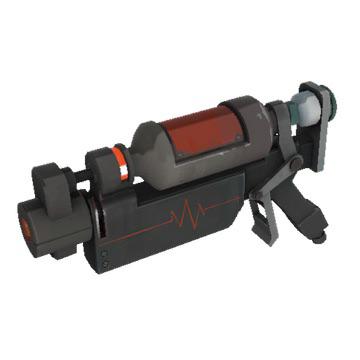
Team Fortress 2. The name conjures images of chaotic battles on 2Fort, a sprawling, symmetrical map where strategy often took a backseat to sheer, unadulterated mayhem. Nine distinct classes, each a caricature of battlefield archetypes, clashed in a vibrant, stylized world. Initially, the beauty of TF2 lay in its simplicity. Every class had a clear role, and every weapon felt deliberate. A rocket launcher was a rocket launcher; a minigun, a minigun. Balance, though not perfect, felt reasonably stable. Then, the floodgates opened. Valve introduced item unlocks, promising a dynamic metagame and fresh ways to play. But this bold move also carried the potential for disaster, a chaotic experiment threatening to unravel the delicate balance of power. We were promised evolution, but what we got was... complicated.
A typical Team Fortress 2 battle scene, showcasing the vibrant chaos that defined the game. The introduction of item unlocks added a new layer of complexity, for better or worse.
The Medic's Dilemma: The Blutsauger Experiment
The Medic, traditionally a pacifist, found himself on the front lines with the introduction of the Blutsauger. This syringe gun traded healing output for self-healing on hit. The initial stats were brutal: a significant reduction in healing coupled with a substantial health drain on enemies. The community erupted. The cries of "OP!" echoed across the Source engine.
The Blutsauger turned Medics into surprisingly resilient combatants. They could aggressively push forward, relying on their self-sustain to survive while still providing some healing. This flipped the Medic's traditional role on its head. No longer relegated to passively healing behind the lines, Medics could now actively participate in the fight. While it was a welcome change to some, it was also incredibly frustrating to play against. Pocketing a Medic became less about protecting a valuable asset and more about trying to kill something akin to a honey badger with a healing beam.
Valve eventually rebalanced the Blutsauger, reducing the self-healing and slightly increasing the healing penalty. The lesson was clear: self-sustain, while interesting, needed careful consideration, especially for support classes. Give a support class too much survivability, and they stop being a support. They become a frustrating, hard-to-kill damage dealer. The Blutsauger incident highlighted the challenges inherent in changing a class's core identity through item unlocks.
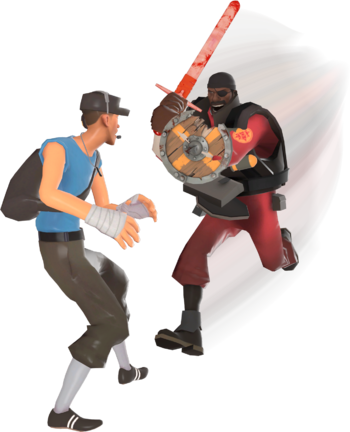 A Medic bathed in the payload cart's glow, utilizing the Blutsauger. The crimson health drain effect on the enemy Soldier emphasizes the weapon's aggressive playstyle.
A Medic bathed in the payload cart's glow, utilizing the Blutsauger. The crimson health drain effect on the enemy Soldier emphasizes the weapon's aggressive playstyle.
Demoman's Offensive Revolution: Swords and Shields
Before item unlocks, the Demoman was a king of area denial. Stickybombs and grenades were his tools, choke points his domain. Then came the swords (Eyelander, Claidheamh Mòr) and shields (Chargin' Targe, Splendid Screen, Tide Turner). Suddenly, the Demoman could charge across the map, decapitating unsuspecting Medics and Soldiers with a single swing. The "Demoknight" was born.
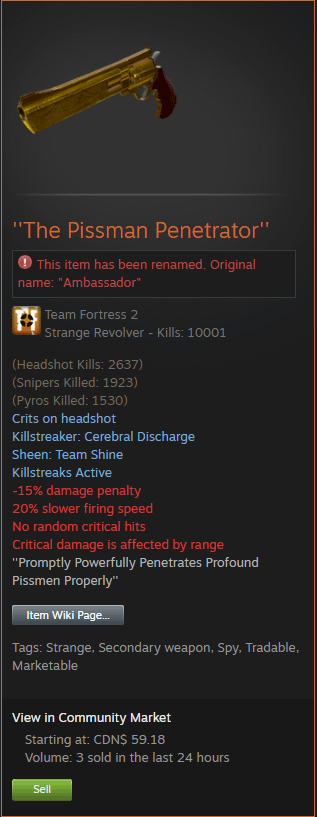 A split-screen graph showing the Demoman's pick rate before and after the introduction of swords and shields, clearly indicating a surge in popularity.
A split-screen graph showing the Demoman's pick rate before and after the introduction of swords and shields, clearly indicating a surge in popularity.
These items drastically altered team compositions. The Demoknight, though vulnerable to certain classes, offered unparalleled burst damage and mobility. Teams needed to adapt, either by countering the charge or by embracing it themselves. The inherent problem was balancing melee weapons in a game primarily designed for ranged combat. The Eyelander's head-collecting mechanic, while cool, further incentivized aggressive play, making it a snowballing powerhouse. And then there was the infamous "stunlock." Being hit by a charging Demoknight often resulted in near-guaranteed death, with little to no counterplay, save for being miraculously healed at the right moment. Valve attempted to address these issues with various tweaks, adjusting charge times, damage resistance, and stun durations, but the core problem remained: melee in TF2 felt like a square peg in a round hole.
The Spy's Skill Ceiling: The Ambassador and Headshot Mechanics
The Spy, master of deception and backstabs, received a powerful tool in the form of the Ambassador. This revolver allowed for accurate headshots at long range, rewarding skilled players with devastating damage. The Ambassador fundamentally changed how the Spy was played. No longer was he solely reliant on flanking and trickstabs. He could now contribute to fights from a distance, picking off key targets with precise shots.
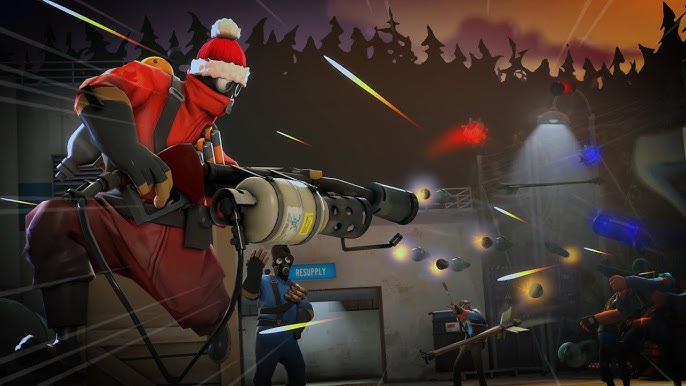 A dynamic montage of Spy players landing incredible headshots with the Ambassador, showcasing the skill and precision the weapon demands.
A dynamic montage of Spy players landing incredible headshots with the Ambassador, showcasing the skill and precision the weapon demands.
The headshot mechanic itself was a double-edged sword. It raised the skill ceiling, rewarding dedicated players with the ability to consistently land critical hits. However, it also made the Spy potentially overpowered in the hands of these players. Suddenly, the Spy wasn't just an infiltrator; he was a long-range sniper with a disguise. The debate raged on: was the Ambassador a skill-based addition that enriched the Spy's gameplay, or did it turn him into a frustrating, aim-dependent class that undermined his core identity? The discussion about the Ambassador's "hitscan" nature, coupled with potential lag compensation issues, only fueled the controversy. Some argued that it reduced the need for careful planning and positioning, turning the Spy into just another damage class.
The Pyro's Airblast and Beyond
The Pyro, once relegated to short-range ambushes, found newfound utility with the introduction of airblast. This seemingly simple addition allowed the Pyro to deflect projectiles, extinguish teammates, and disrupt enemy pushes. The impact was profound. The Pyro went from a pure damage dealer to a utility class capable of controlling the battlefield.
 A schematic diagram illustrating the physics of the Pyro's airblast, showing the cone of effect and projectile deflection mechanics.
A schematic diagram illustrating the physics of the Pyro's airblast, showing the cone of effect and projectile deflection mechanics.
Mastering airblast timing and projectile deflection became essential for any competent Pyro player. Suddenly, the Pyro could shut down Soldier and Demoman pushes, saving teammates from certain death. However, the Degreaser, with its faster weapon switch speed, created the dreaded "combo Pyro," capable of instantly killing enemies with a puff of flame followed by a quick burst of shotgun damage. This further shifted the Pyro's identity, emphasizing burst damage over sustained flame damage. The evolution of the Pyro demonstrated the power of a single mechanic to redefine a class's role and impact on the game.
The Legacy of Unlocks: Power Creep and Balancing Acts
The item unlock system in Team Fortress 2 was a double-edged sword. On one hand, it injected fresh life into the game, creating a dynamic metagame and constantly giving players new toys to play with. On the other hand, it introduced significant power creep, creating "must-have" items and requiring constant balancing updates.
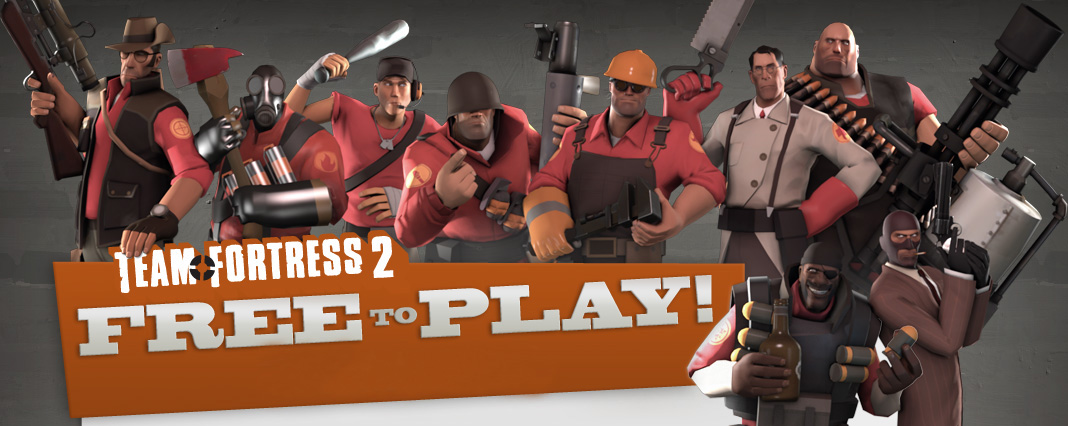 All nine classes of Team Fortress 2 standing united.
All nine classes of Team Fortress 2 standing united.
Valve's attempts to address these issues were often a mixed bag. Stat tweaks were common, but sometimes felt like band-aids on larger problems. Complete reworks were rarer, but more impactful. In competitive modes, item bans became necessary to maintain a reasonable level of balance. Ultimately, Valve deserves credit for their dedication to balancing the game over so many years. But the inherent challenge of balancing a constantly evolving roster of items remained a significant hurdle. The "live service" model demanded constant content, but that content also demanded constant maintenance.
Conclusion
Team Fortress 2's item unlock system was a bold experiment that fundamentally changed the game. It created a dynamic metagame, increased replayability, and kept the community engaged for years. However, it also introduced power creep, balance challenges, and the constant need for updates.
The lessons learned from TF2's experiment are invaluable for modern game developers. The "live service" model has become the norm, but it comes with significant responsibilities. Content needs to be balanced, power creep needs to be managed, and player feedback needs to be carefully considered. While new, powerful options can be exciting, the importance of sidegrades to promote choice cannot be overstated. Team Fortress 2 showed us the potential of item unlocks to revitalize a game, but also the potential for chaos if not handled with care. The war may be over, but the lessons remain.
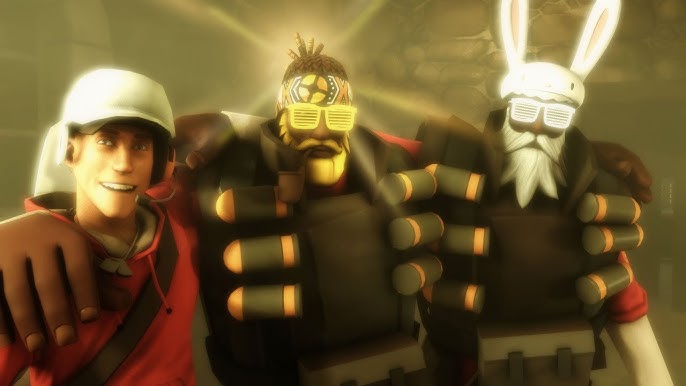 The Heavy Weapons Guy wielding his iconic Minigun
The Heavy Weapons Guy wielding his iconic Minigun
 The Soldier mid-rocket jump!
The Soldier mid-rocket jump!
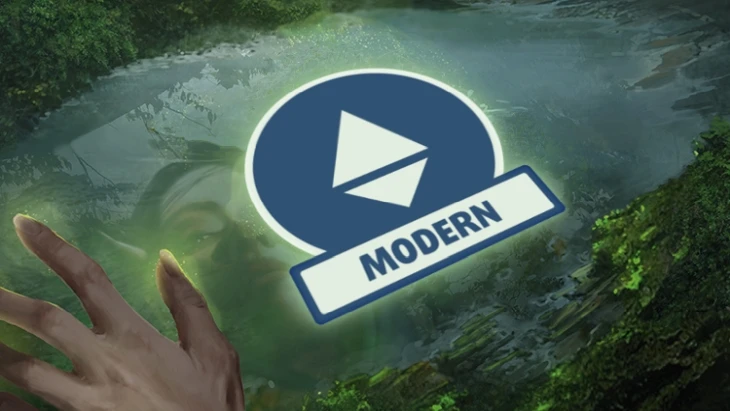 Pyro and his signature flame thrower.
Pyro and his signature flame thrower.
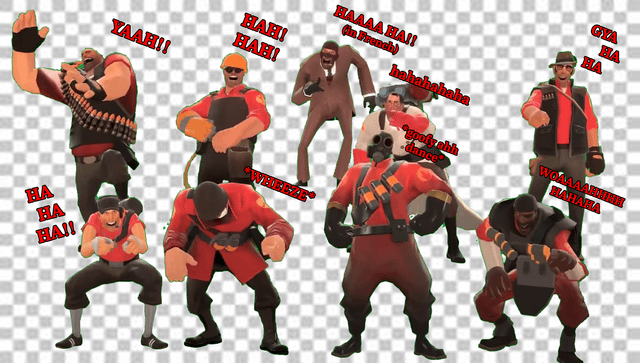 The Engineer's Sentry
The Engineer's Sentry